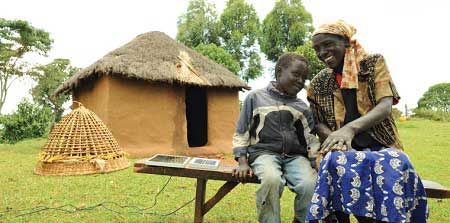The math for Africa’s clean energy future is adding up. Solar lamps are spreading like fireflies across Ghana. A first-of-its-kind solar farm in Rwanda is providing electricity for 15,000 rural homes. Utility-scale solar and wind projects are being built in Morocco and Kenya. As technology costs keep tumbling, centralized and decentralized renewable projects such as these will become increasingly attractive, especially when compared with the costly diesel fuel generation that provides much of the continent’s power in rural areas.
Yet, as reporter Tom Jackson previously pointed out in this magazine, hundreds of millions of Africans — including more than 75 percent of the populations in countries such as Ethiopia, Sierra Leone and Uganda — are still living without power. The gap is especially glaring in sub-Saharan African countries, which account for 13 percent of the world’s population but a whopping 48 percent of the global population without access to electricity. Even those who have electricity face very high prices for insufficient and unreliable supplies.
The continent’s continued dependence on yesterday’s energy solutions is due in large part to money — or the lack of it. There’s simply not enough investment capital flowing into African clean energy projects.
The dearth of private institutional investor capital, such as U.S. and European pension funds, which manage trillions of dollars, is especially glaring. While utility-scale projects such as Morocco’s 510-megawatt solar project and Kenya’s 300-MW wind project have secured key financing to begin construction — the first 160-MW phase of Morocco’s project will begin operating later this year — nearly all of the capital was from public sector sources such as the World Bank and African Development Bank.
It’s important these projects are being built. In fact, they were largely responsible for global clean energy investments reaching a record US$131 billion last year in developing countries, including a highest-ever US$12.6 billion in Africa and the Middle East. Two African countries, South Africa and Kenya, attracted more than US$1 billion in clean energy investments in 2014.But public investment is not enough. Despite having a staggering potential solar capacity — an estimated 8.8 million MW in sub-Saharan Africa alone, according to management consulting firm McKinsey — renewable energy installations are not happening at nearly the rate necessary to reach the Clean Trillion goal of more than quadrupling investments in global clean energy by 2030.
“Private-sector involvement is critical and central to effectively delivering new capacity [in Africa],” concludes McKinsey’s recent Powering Africa report.
In sub-Saharan Africa alone, an additional US$450 billion in power-sector capital investment is needed to cut power outages in half and achieve universal energy access in urban areas by 2040, according to the IEA’s Africa Energy Outlook report. Mini-grids and off-grid systems, especially those using solar, hydro and wind, hold especially strong promise to bring substantially more power to rural areas, the IEA report concludes.
 Photo by Andres Bifani/Lighting Africa
Photo by Andres Bifani/Lighting Africa
So what’s keeping investors on the sidelines in Africa, home of many of the world’s fastest growing economies?
It’s about creating trust. Investors hate risk — whether real or perceived. They need assurances that regulations are stable and will not shift. They need to be absolutely sure that their investments, whether direct or indirect, will generate reliable, attractive long-term returns.
Let’s start with government signals. More African countries need to adopt targets, policies and regulations that support renewable energy production. A case in point is Sierra Leone, which still makes it very hard for independent power producers to operate. An encouraging sign is a growing number of African countries — Egypt, Kenya, Uganda and South Africa, among them — now have feed-in policies where the government guarantees a price (often at a premium) to compensate producers for certain types of renewable energy. Rwanda is another: The country has set ambitious goals to expand renewable energy and recently unveiled the region’s first solar mini-grid, serving 15,000 rural households.
Enacting policies to reduce capital costs and risks is also important. Governments can help reduce transaction costs by promoting contract standardization and securitization.
De-risking policies can also help. A key reason Kenya’s US$1 billion wind project near Lake Turkana is moving forward, for example, is that the African Development Bank provided US$24.5 million in risk guarantees to cover potential delays in finishing a key transmission line, which is crucial for the project.
The fact that many sustainable energy projects are too small to attract large investment funds is another hurdle. One type of financing innovation that offers early promise in some emerging markets is that of Yieldscos, publicly traded companies that finance new clean energy projects by offering investors the promise of steady dividends based on project cash flows. Among those taking advantage is Sun Edison’s Yieldco, TerraForm Global, which operates clean energy plants in South Africa, India and several other countries generating nearly 1,000 MW.
It’s easy to quibble that more must be done to smooth Africa’s operating environment for renewables, but evidence is growing that clean energy is gaining ground and opportunities exist.
Success breeds success. As more financing innovations are utilized and more projects are successfully completed, investors — especially private institutional investors — will have no choice but to join Africa’s clean energy future.
This story has been published with permission from the original publication by our partners at ENSIA By Peyton Fleming.















Comments